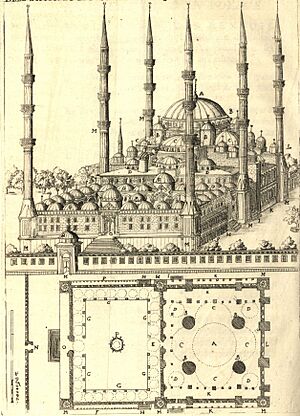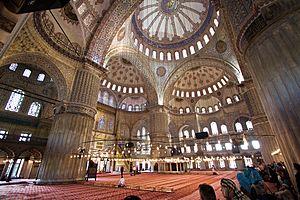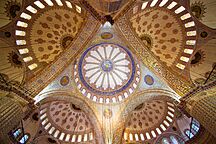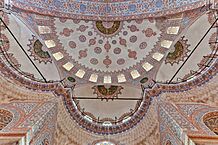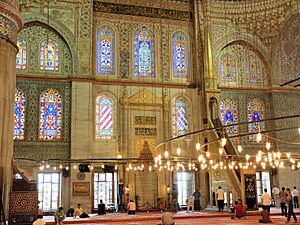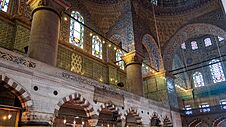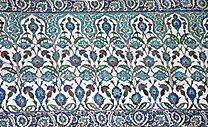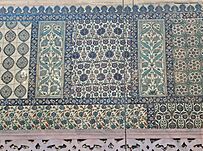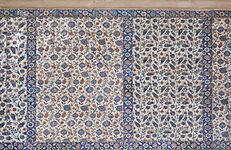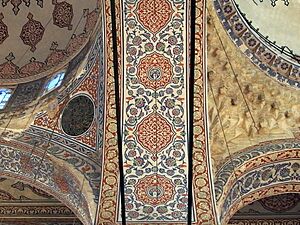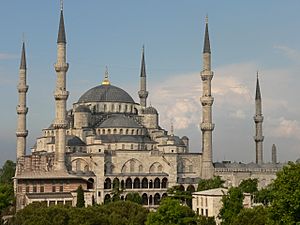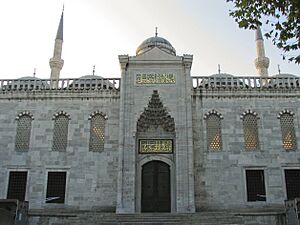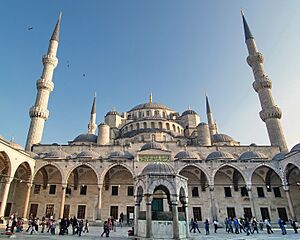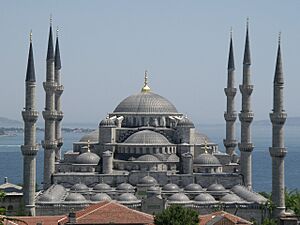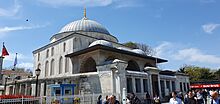Blue Mosque, Istanbul facts for kids
Quick facts for kids Blue Mosque, Istanbul |
|
|---|---|
 |
|
| Religion | |
| Affiliation | Islam |
| Location | |
| Location | Fatih, Istanbul, Turkey |
| Architecture | |
| Architect(s) | Sedefkar Mehmed Agha |
| Architectural type | Mosque |
| Architectural style | Islamic, Classical Ottoman |
| Groundbreaking | 1609 |
| Completed | 1617 |
| Specifications | |
| Capacity | 10,000 |
| Length | 73 m (240 ft) |
| Width | 65 m (213 ft) |
| Dome height (outer) | 43 m (141 ft) |
| Dome dia. (inner) | 23.50 m (77.1 ft) |
| Minaret(s) | 6 |
| Minaret height | 64 m (210 ft) |
| Materials | |
| UNESCO World Heritage Site | |
| Part of | Historic Areas of Istanbul |
| Criteria | Cultural: i, ii, iii, iv |
| Inscription | 1985 (9th Session) |
| Website | |
| Official website: https://www.sultanahmetcami.org | |
The Blue Mosque, also known as the Sultan Ahmed Mosque (in Turkish, Sultan Ahmet Camii), is a famous historical mosque in Istanbul, Turkey. It was built a long time ago, between 1609 and 1617, when Ahmed I was the Sultan of the Ottoman Empire. Even today, it is still used as a mosque where people pray.
This beautiful building is also a very popular place for tourists to visit. It is one of the most well-known examples of Ottoman architecture. The mosque has a classic design with a big central dome. Four smaller domes, called semi-domes, surround the main dome over the prayer area.
Outside, there is a large courtyard and six tall towers called minarets. Inside, the mosque is decorated with thousands of special Iznik tiles. It also has painted flowers, mostly in blue colors. This is why people often call it the "Blue Mosque." The mosque is part of a larger complex of buildings, called a külliye. This complex includes Sultan Ahmed's tomb, a school (called a madrasa), and other buildings.
The Blue Mosque is located right next to the old Hippodrome, which was once a huge arena. It also stands across from the Hagia Sophia, another very famous building. In 1985, the Blue Mosque became part of the UNESCO World Heritage Site called "Historic Areas of Istanbul."
Contents
History of the Blue Mosque
How the Mosque Was Built

After a peace treaty that made the Ottoman Empire feel less powerful, Sultan Ahmed I decided to build a grand mosque in Istanbul. He hoped this would bring good fortune from God. He was the first sultan in many years to build such a large imperial mosque.
The mosque was built in a very important spot. It was on the southeast side of the old Byzantine Hippodrome. This location was close to the Hagia Sophia, which was the most important mosque at the time. Building it here made sure the new mosque would stand out in the city's skyline. The area used to have seats and an imperial box for the emperor at the Hippodrome. Some of these old seats were found during digs in the early 1900s. Sultan Ahmed likely wanted his mosque to be as grand as, or even grander than, the Hagia Sophia.
Before building could start, the land had to be bought from several important officials. This was very expensive. Also, the empire was facing money problems. Because of this, some religious scholars, called the ulema, protested. They believed sultans should only use money from war victories to build mosques. Sultan Ahmed I had not won any big wars, so he had to use money from the government's treasury. The ulema even said that Muslims should not pray at the new mosque.
Despite these challenges, the sultan went ahead with his plan. Construction began in 1609 and was finished in 1617. The opening ceremony happened that year, though some records say 1616. Sultan Ahmed I passed away around the same time in 1617. Some historians believe he died just before the mosque was fully completed.
In the end, the mosque's amazing size, beautiful decorations, and the grand ceremonies Sultan Ahmed I held won over the public. It became one of the most loved mosques in Istanbul. The mosque has had such a big impact that the area around it is now called Sultanahmet.
Repairs and Upgrades
In 1883, many of the painted designs inside the mosque were changed. New stenciled patterns replaced them, and some of the original colors were altered. A large fire in 1912 damaged some of the buildings around the mosque, which were later fixed.
A big restoration project for the mosque started in the 21st century. In 2013, during early work, it was found that one of the minarets had moved about 5 centimeters. This could have made it unstable. Work to fix this minaret began in 2015. A full restoration of the entire mosque started in 2018 and was completed in April 2023.
Mosque Architecture
Design Overview
The design of the Blue Mosque was inspired by the earlier Şehzade Mosque, built in the 1500s. The main prayer hall is about 64 by 72 meters. It has a large central dome that is 23.5 meters wide. This main dome is surrounded by four smaller semi-domes. Each semi-dome has three even smaller semi-domes next to it. Four small domes cover the corners of the prayer hall. Outside, the mosque has six minarets, places for washing, and a big courtyard before the prayer hall.
The architect, Sedefkar Mehmed Agha, used ideas from his teacher, Sinan. He wanted the mosque to be incredibly large, grand, and splendid. His official biographer said this mosque was the best work of his career. The building shows the classical Ottoman style of that time. It also includes ideas from Byzantine architecture, like the nearby Hagia Sophia, mixed with Islamic architecture. It was the last major mosque built in this classical style.
Historians note that Mehmed Agha focused more on the small details and breaking up the building's parts. This was a bit different from Sinan, who focused on strict overall designs with simpler decorations. Another scholar, Gülru Necipoğlu, says the mosque shows a new trend. Buildings at this time were becoming more extravagant in their design and decoration. You can see this in the mosque's size, its many minarets, and the lavish use of Iznik tiles.
Even though some experts have pointed out small flaws compared to Sinan's earlier works, the Blue Mosque is still one of the most impressive and admired buildings of Ottoman architecture.
Inside the Mosque
Layout and Main Features
The inside of the mosque is dominated by its huge central dome and the smaller semi-domes that flow down from it. The main dome reaches a height of 43 meters. Four massive, round pillars support the weight of this dome. Smooth, curved sections, called pendentives, connect the round dome to the square pillars. Smaller pendentives are used for the semi-domes. The spaces between the smaller semi-domes and the walls are filled with muqarnas, which are like stalactite-shaped carvings made of plaster. These elements help the building smoothly change from its rectangular outer walls to the round central dome.
A two-story gallery, supported by columns, runs along three sides of the prayer hall. The floor is covered with soft carpets. These carpets are gifts from worshippers and are replaced regularly when they wear out.
At the front of the prayer hall is the mihrab. This is a beautifully carved marble niche that shows the direction of Mecca, where Muslims pray. It has two special inscription panels above it with verses from the Qur'an. Many windows surround the mihrab. To its right is the richly decorated minbar, or pulpit. This is where the imam (the prayer leader) stands to give sermons on Fridays and holy days. The minbar is made of finely carved marble and has a golden top. The mosque was designed so that everyone inside, even when it's very crowded, can see and hear the imam.
The hünkâr mahfil is a special raised platform in the southeast corner. This was where the sultan would pray. It is shaped like an "L" and stands on ten marble columns. It has its own mihrab with rich decorations, which once included gold and a jade rose. The sultan could reach this platform from outside through an "imperial pavilion." This pavilion had a ramp and two rooms where the sultan could rest. This special structure for the sultan was a new idea in Ottoman architecture.
Beautiful Decorations
The lower walls of the mosque, especially around the galleries, are covered with Iznik tiles. These beautiful tiles are named after the town of İznik, where they were made. Sultan Ahmed I loved these tiles so much that the Iznik tile workshops focused only on making tiles for his mosque during its construction. In 1613, the sultan even stopped the production of tiles for anyone else, just to make sure his mosque's order was finished on time.
There are 21,043 tiles inside the mosque, with over fifty different designs. Some panels were made just for the mosque. Others seem to have been moved from other buildings. The most beautiful tiles are on the walls of the upper gallery on the north side. They show cypress trees, flowers, and fruit in many colors like blue, green, red, black, and turquoise.
About 75 percent of the mosque's walls, above the tiled areas, are covered with painted designs. The main color used in these paintings is blue. This is one of the reasons the mosque is called the Blue Mosque. These painted designs usually show floral arabesques, which are flowing plant patterns. Other decorations include calligraphic writings, with verses from the Qur'an. These were originally done by a famous calligrapher named Seyyid Kasim Gubari. However, they have been restored many times and no longer look exactly like the originals.
Some special floor decorations, called opus sectile, are also used. The mosque also has high-quality wooden carvings, including the doors at the courtyard entrance.
The mosque has about 260 windows to let in natural light. Each semi-dome has 14 windows, and the central dome has 28. Many windows were made in a traditional way with small pieces of colored glass creating complex patterns. Some of the glass was made locally, but most of the colored glass was imported. Some was even a gift from Venice in 1610. Most of these original windows have been replaced with simpler modern ones. The modern windows likely make the mosque brighter inside today than it was originally.
Chandeliers hanging from the ceiling also light up the mosque. The many lamps inside were once covered with gold and gems. They even had ostrich eggs and crystal balls. Ostrich eggs were often added to chandeliers in mosques and churches. People in Istanbul say it was to keep spiders or mice away, or to warn of earthquakes. Some crystal balls also held interesting items, like models of the mosque or a ship.
Outside the Mosque
On the outside, Mehmed Agha designed the mosque with a cascade of domes and semi-domes. These, along with curved supports, create a soft shape that smoothly rises to the top of the central dome. This style is a bit different from earlier Ottoman architects, who used sharper contrasts between curved domes and straight vertical parts.
The mosque's courtyard has three entrances. The main one is in the northwest and is very grand. It has a tall, projecting doorway topped by a small dome. This doorway is decorated with muqarnas carvings and two inscription panels. From the courtyard, you can enter the prayer hall through another grand gate on the southeast side. This gate also has muqarnas and an inscription. There are two other side entrances to the prayer hall from outside the mosque, which tourists often use today.
Inside, the mosque courtyard is a classic rectangle. It is surrounded on all sides by an arcade (a row of arches) with domes above them. There are 26 columns supporting these arcades and 30 domes. In this mosque, the arches in front of the prayer hall are about the same height as the others. This makes the courtyard look more uniform.
In the center of the courtyard is the shadirvan. This is an octagonal (eight-sided) domed kiosk that shelters a fountain. This fountain was used for ablutions, which are ritual washings before prayer. Today, people usually perform ablutions at water taps outside the courtyard walls. These taps under arcaded galleries were a new idea at the time.
A heavy iron chain hangs at the northwestern entrance to the mosque's outer area. Only the sultan was allowed to enter the mosque's courtyard on horseback. The chain was placed there so that the sultan had to lower his head every time he entered. This was a symbolic way to show that even the ruler had to be humble before God.
The Minarets
The Blue Mosque is one of only a few mosques in Turkey that has six minarets. A popular story says that the architect misunderstood the Sultan's request. The Sultan asked for "altın minareler" (gold minarets), but the architect heard "altı minare" (six minarets). At that time, only the Great Mosque of Mecca had six minarets. To solve the problem, the Sultan then ordered a seventh minaret to be built at the Mecca mosque.
Each of the six minaret towers has vertical grooves, called fluting, and is topped with a slender, pointed cap. The four minarets at the corners of the prayer hall each have three balconies, called şerefe. The two minarets at the outer corners of the courtyard have two balconies each. Each balcony is supported by muqarnas carvings. The minarets have been repaired many times over the years. In the past, the muezzin (the person who calls Muslims to prayer) would climb a narrow spiral staircase inside the minarets five times a day to make the call.
Other Buildings in the Complex
Like most large Ottoman religious complexes, the Sultan Ahmed Mosque is the main part of a group of buildings. These other buildings are not arranged in a perfect plan around the mosque. Because the mosque was built next to the Hippodrome, it was hard to plan the complex perfectly. So, the other buildings were placed in different spots near the mosque or around the Hippodrome. An outer wall surrounds the mosque and its precinct.
Sultan Ahmed I's Mausoleum
The tomb of Sultan Ahmed I is located northeast of the mosque, near the Hippodrome square. It was started in 1619, after Ahmed's death, and finished by his son, Osman II. Unlike many Ottoman tombs, which are often eight-sided, this tomb chamber is square with a dome. The dome is 15 meters wide. Inside, you can find the tombs of Sultan Ahmed I and some of his family. This includes his wife Kösem Sultan and four of his sons, including Sultan Osman II and Sultan Murad IV.
The Madrasa (School)
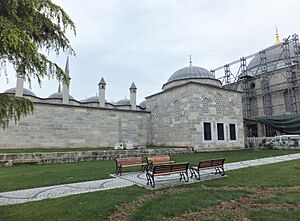
The madrasa (a religious school) of the complex is just outside the mosque's outer wall, to the northeast. It was likely finished around 1620. This school has a classic design: a rectangular courtyard surrounded by an arcaded portico with domes. Behind each portico are rows of domed rooms where students lived. There are 24 such rooms. A special classroom, called the dershane, is attached to a corner of the building.
A separate square building, the darülkurra, is also nearby. This was a school for teaching how to read the Qur'an. It was restored in 1935 and is now used to store old Ottoman documents.
Hospital and Public Kitchen
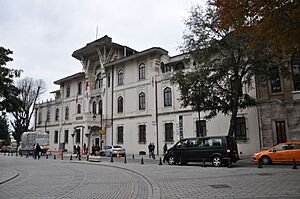
Four other buildings of the complex were built over the old Hippodrome. The largest was a hospital (called darüşşifa), a square building with an inner courtyard. It was built between 1609 and 1620. It included a bathhouse (hammam) and a small mosque.
Next to the hospital were three other buildings in a row. These made up the imaret, which was a public kitchen that provided food. These buildings were started in 1617 and likely finished in 1620. They included a pantry, a kitchen with an oven, and a dining hall. There were also guesthouses nearby, but these are no longer there.
In the 1800s, the hospital and guesthouses were destroyed. An academy was built on that site. The academy building burned down in the 1970s but was later restored. It is now used by Marmara University. The surviving parts of the public kitchen buildings are now part of this university building.
Other Buildings
The primary school (sibyan mektebi) is a small, simple rectangular building. It was built on the outer wall of the mosque's precinct on the east side. It was finished around 1617 but was destroyed by a fire in 1912. It has since been restored.
To the south, there was a bathhouse (hammam). It was probably finished in 1617. It is now partly in ruins. Its furnace room, warm room, and hot room are still mostly standing. However, the front part of the building, which was likely made of wood, is gone.
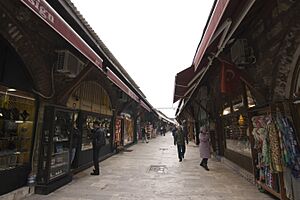
Below the southeast side of the mosque complex is an arasta, which is a market street or bazaar. It was built as part of the complex and had spaces for about 200 shops. It was also completed in 1617. In 1912, a fire destroyed it. However, it was restored between 1982 and 1985. Today, it is open as a bazaar, especially for tourists.
Pope Benedict XVI's Visit
Pope Benedict XVI visited the Blue Mosque on November 30, 2006. This was a very special event because it was only the second time a Pope had visited a Muslim place of worship. The Pope took off his shoes and stood in silent prayer for two minutes. He stood next to Mustafa Çağrıcı, the Mufti of Istanbul, and Emrullah Hatipoğlu, the Imam of the Blue Mosque.
The Pope expressed his gratitude for this visit. He said, "May all believers identify themselves with the one God and bear witness to true brotherhood." He also noted that Turkey "will be a bridge of friendship and collaboration between East and West." He thanked the Turkish people for their kindness, saying he felt loved and understood during his stay.
See also
 In Spanish: Mezquita Azul para niños
In Spanish: Mezquita Azul para niños
- List of mosques in Istanbul
- Çamlıca Mosque
- Shah Mosque
- List of tallest domes
- List of tallest structures built before the 20th century


